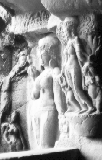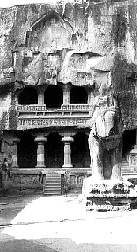
ELLORA

ELLORA
ALL IMAGES AND TEXT OWNED BY AUTHOR
 Located about
30 Kilometres from Aurangabad, these caves are known for the genius of their
sculptors. It is generally believed that these caves were constructed by
the sculptors who moved on from Ajanta. This cave complex is multicultural,
as the caves here provide a mix of Buddhist, Hindu and Jain religions. The
Buddhist caves came first, about 200 BC - 600 AD followed by the Hindu 500
- 900 AD and Jain 800 - 1000 AD.
Located about
30 Kilometres from Aurangabad, these caves are known for the genius of their
sculptors. It is generally believed that these caves were constructed by
the sculptors who moved on from Ajanta. This cave complex is multicultural,
as the caves here provide a mix of Buddhist, Hindu and Jain religions. The
Buddhist caves came first, about 200 BC - 600 AD followed by the Hindu 500
- 900 AD and Jain 800 - 1000 AD.

Buddhism was on its way out of central India by the end of the seventh century. This is obvious from the cave depiction of the divisions within the Buddhist faith, with Hinayana losing ground over Mahayana. The Buddhist caves were essentially used for prayers and were simple structures, at most with a Stupa (a semi-dome structure). Mahayana or the more dynamic vehicle replaced the Stupa with the idol of Buddha as a central figure in substantial and ornate halls where preachers (monks) lived and worshipped.
The idol was depicted as having characteristic attributes of divinity, thirty-two in all. The most apparent are the long ear-lobes, long arms, the robe, curled hair and a halo.
 The simplicity of the Buddhist caves (viharas) is in contrast with the austerity of the
Hindu caves (chaityas). The Kailas temple, classified as Cave number sixteen
is indeed an obvious example. Sculpted out of a sheer rock face, any superlatives
to define its magnificence, would merely be an understatement. This is not
only a conversion of a vihara into a temple (as seen elsewhere in the cave
complex at Ellora), but a fine example of what could be achieved with a chisel
and hammer!
The simplicity of the Buddhist caves (viharas) is in contrast with the austerity of the
Hindu caves (chaityas). The Kailas temple, classified as Cave number sixteen
is indeed an obvious example. Sculpted out of a sheer rock face, any superlatives
to define its magnificence, would merely be an understatement. This is not
only a conversion of a vihara into a temple (as seen elsewhere in the cave
complex at Ellora), but a fine example of what could be achieved with a chisel
and hammer!
Kailasa - home of Shiva in the Himalayas has been represented in a temple form at Cave sixteen. This sculpture is regarded as the greatest monolithic sculptures in the world. The temple was sculpted in the reign of the Chalukya and Rashtrakuta Kings. The resurgence of Hinduism is evident in the grandeur of the sculpture. Kailasa depicts size and grace like no other sculpture in the world. It is said to have been built in the reign of the Rashtrakuta King, Krishna I, around 760 AD.
 Life size elephants
are carved in the sides of the central structure and are dwarfed by the sheer
size of the 30 meter cliffs that surround the temple. Massive panels are
sculpted on the walls within the temple courtyard which depict several
mythological events and scriptures like for example, the epic Ramayana.
Life size elephants
are carved in the sides of the central structure and are dwarfed by the sheer
size of the 30 meter cliffs that surround the temple. Massive panels are
sculpted on the walls within the temple courtyard which depict several
mythological events and scriptures like for example, the epic Ramayana.
In the late 17th century however, the advancing Moguls, especially Aurangzeb AURANGABAD) defaced the temple. He called the Kailas temple and its representations 'heathen idols'. The scars are evident everywhere in the temple courtyard, yet the magnificence remains and one can easily spend a few hours looking around in awe.

In this part of the world, some of the Hindu shrines of the period were masked with typical
Mogul architectural features. This to avoid the hammer of destruction, wielded
by those intent on destroying religious icons or replacing or altering them
with their own religious shrines. The temple and courtyard
in DAULATABAD is an
example of such alteration, where pillars of a pillaged Jain temple were
used to build a mosque.
 Nottingham
Business School Home Page
Nottingham
Business School Home Page
 The Nottingham Trent University Home Page
The Nottingham Trent University Home Page